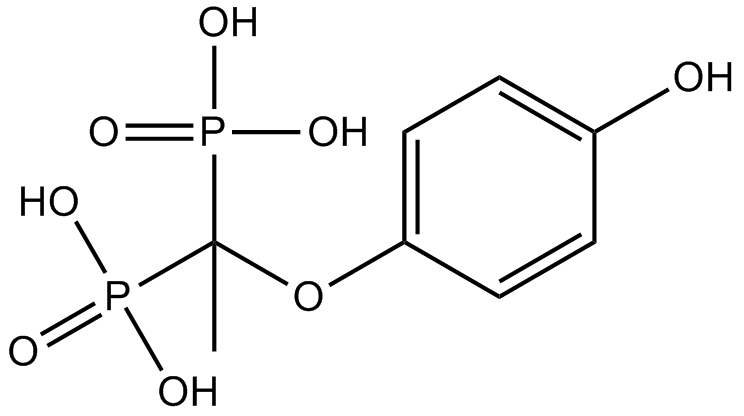L-690,330
L-690,330 is a competitive inhibitor of inositol monophosphatase (IMPase) with a Ki value of between 0.2 and 2 μM depending on the source of IMPase [1].
In the phosphatidylinositol (PI) cycle cell signalling pathway, IMPase is involved as a key enzyme. Inositol monophosphates, inositol(1)phosphate [Ins(l)P], inositol(3)phosphate [Ins(3)P], and inositol(4)phosphate [Ins(4)P] are hydrolyzed by IMPase and produce free inositol. Free inositol can then be used to synthesize PI [1].
In carbachol-stimulated m1 CHO cells, the treatment with L-690,330 alone did not increase the amount of [3H]InsP1. In the absence of L-690,330, the treatment with carbachol alone increased levels of [3H]InsP1, resulted in levels ranging from 20 to 100% above basal [3H]InsP1 levels. In the presence of carbachol, lithium at 10 mM increased the amount of [3H]InsP1 by approximate five folds (relative to [3H]InsP1 levels in carbachol-stimulated cells) and the EC50 value of this effect was about 1 mM. In carbachol-stimulated cells, L-690,330 at 10 mM resulted in only ~40% of the maximum response seen in the case with lithium treatment [1].
In mouse brains, in the absence of L-690,330, pilocarpine produced approximately doubled levels of Ins(1)P. In the absence of pilocarpine, L-690,330 did not affect Ins(1)P levels. Under pilocarpine-stimulated conditions, treatment with L-690,330 resulted in a pronounced accumulation of Ins(1)P, with the maximum level observed 1 h after injection. The maximum was of an approximate four-fold elevation [1].
Reference:
[1]. Atack JR, Cook SM, Watt AP, et al. In Vitro and In Vivo Inhibition of Inositol Monophosphatase by the Bisphosphonate L-690,330. Journal of neurochemistry, 1993, 60(2): 652-658.
| Physical Appearance | Off-white solid |
| Storage | Store at RT |
| M.Wt | 298.13 |
| Cas No. | 142523-38-4 |
| Formula | C8H12O8P2 |
| Solubility | <29.81mg/ml in H2O |
| Chemical Name | (1-(4-hydroxyphenoxy)ethane-1,1-diyl)diphosphonic acid |
| SDF | Download SDF |
| Canonical SMILES | CC(Oc(cc1)ccc1O)(P(O)(O)=O)P(O)(O)=O |
| Shipping Condition | Small Molecules with Blue Ice, Modified Nucleotides with Dry Ice. |
| General tips | We do not recommend long-term storage for the solution, please use it up soon. |
| Cell experiment [1]: | |
|
Cell lines |
M1 CHO cells |
|
Preparation method |
The solubility of this compound in sterile water is 100 mM. General tips for obtaining a higher concentration: Please warm the tube at 37 °C for 10 minutes and/or shake it in the ultrasonic bath for a while. Stock solution can be stored below - 20 °C for several months. |
|
Reacting condition |
0.1 ~ 10 mM |
|
Applications |
In Carbachol-stimulated m1 CHO cells, L-690,330 alone did not increase the amount of [3H]InsP1; lithium alone slightly elevated the amount of [3H]InsP1; Carbachol alone increased the amount of [3H]InsP1 ranging from 20 to 100%. |
| Animal experiment [1]: | |
|
Animal models |
Pilocarpine-stimulated mice |
|
Dosage form |
0 ~ 1 mmol/kg; s.c. |
|
Applications |
In Pilocarpine-stimulated mice, L-690,330 dose-dependently increased brain Ins(1)P levels, with the ED50 values of 0.3 mmol/kg. L-690,330 induced a maximal increase in the Ins(1)P level (about 4-fold) 1 hr after injection. |
|
Other notes |
Please test the solubility of all compounds indoor, and the actual solubility may slightly differ with the theoretical value. This is caused by an experimental system error and it is normal. |
|
References: [1]. Atack JR, Cook SM, Watt AP, et al. In Vitro and In Vivo Inhibition of Inositol Monophosphatase by the Bisphosphonate L-690,330. Journal of neurochemistry, 1993, 60(2): 652-658. | |
Quality Control & MSDS
- View current batch:
-
Purity = 98.00%
- COA (Certificate Of Analysis)
- MSDS (Material Safety Data Sheet)
- Datasheet
Chemical structure









